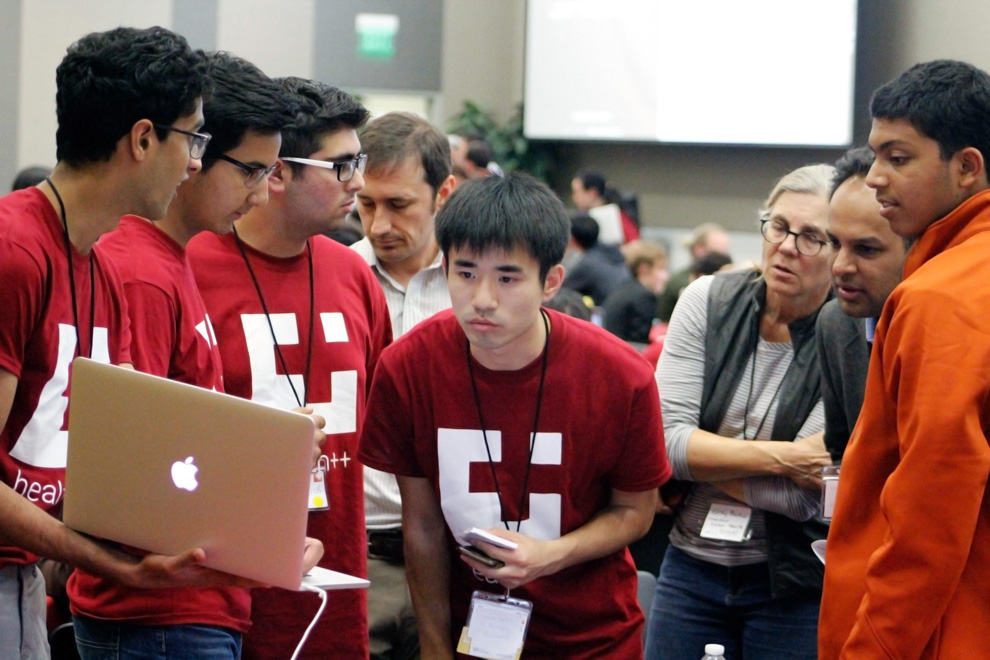More than 200 students gathered on campus this weekend to participate in the inaugural session of health++, a healthcare-focused hackathon hosted by student group Stanford Health Innovations in Future Technologies (SHIFT).
Over the course of two days, participants worked in teams to design and present solutions to some of the most pressing issues today in healthcare. Attendees came from across the country and ranged in experience from first-year undergraduates to postdoctoral candidates. Their academic and technical backgrounds were just as diverse.
“The good thing about [health++] is that people from medicine, people from technology, people from business are all working together across disciplines to produce something cool,” said attendee Sidd Kumar, a B.S./M.S. candidate in computer science at the University of Texas in Austin. “The interdisciplinary factor is what makes this conference unique.”
Students were encouraged to keep this year’s theme, healthcare affordability, in mind during the pitching and design processes. During the opening ceremony, keynote speaker Jessica Mega ’96, Chief Medical Officer at Verily (formerly Google Life Sciences), discussed identifying and approaching a problem from the joint perspectives of health and technology. Before the hacking began, all participants also attended a panel of medical and technical professionals before identifying possible focuses for solutions during an hour-long “problem pitching” session.
“When I think about hackathons, I thought that people would walk in and just immediately starting to code,” said Arjun Kumar ’20, a hackathon participant from Stanford. “The great thing about health++ is that it’s been more about understanding systemic problems behind health care affordability and trying to tackle those problems in a more interdisciplinary and intelligent way.”
Participants in health++ responded to this need-focused approach to hacking by tackling a wide range of issues, ranging from patient-doctor communication to diagnostic imaging.
“The hackathon is really based on validated needs,” said Jason Wang ’18, one of the directors of health++. “Every project that comes out of [health++] is based on something validated by maybe a clinician or someone who has seen the problem or disease firsthand. The goal is for [health++] and all the projects made here to have the potential for impact on real patients.”
The idea to organize health++ came from Wang’s experience with his co-director and fellow Stanford student Shivaal Roy ’18 at MIT’s Global Oncology Hackathon, which took place this February. Both Wang and Roy come from engineering backgrounds, but their project was based on an idea pitched by a pediatric oncologist on their team.
“As we were working, we had a plan for what we wanted to make,” Roy said. “But only through [this oncologist’s] expertise were we able to figure out if our idea would actually solve the problem. And so, we thought we really needed that collaboration between technical talent and medical expertise to be able to make something impactful.”
Once they returned to Stanford, Wang and Roy tried to foster the same collaboration between disciplines through health++, working with SHIFT co-founders Shannon Xue ’16 and Sherman Leung ’16 to plan the initiative.
According to Roy, the name “health++” was chosen to reflect the interdisciplinary nature of the event.
“We wanted to avoid using the word “hack” because that has different connotations in different disciplines,” Roy said. “Instead, we chose ‘health++’ because ‘++’ means “to increase” in computer science. [The name] really encompasses our mission to bring together people from different disciplines, and it’s a name that means something special to each discipline.”
While health++ is only in its first year, Wang and Roy are optimistic about the impact the event has had on its participants and hope to see the initiative grow in the future.
“We know that two days is definitely not enough time to create a solution that can truly impact patients,” Wang said. “The goal is for health++ to be a launchpad to foster future collaborations between the different disciplines. It’s just planting the seed.”
Contact Cindy Kuang at ckuang ‘at’ stanford.edu.
